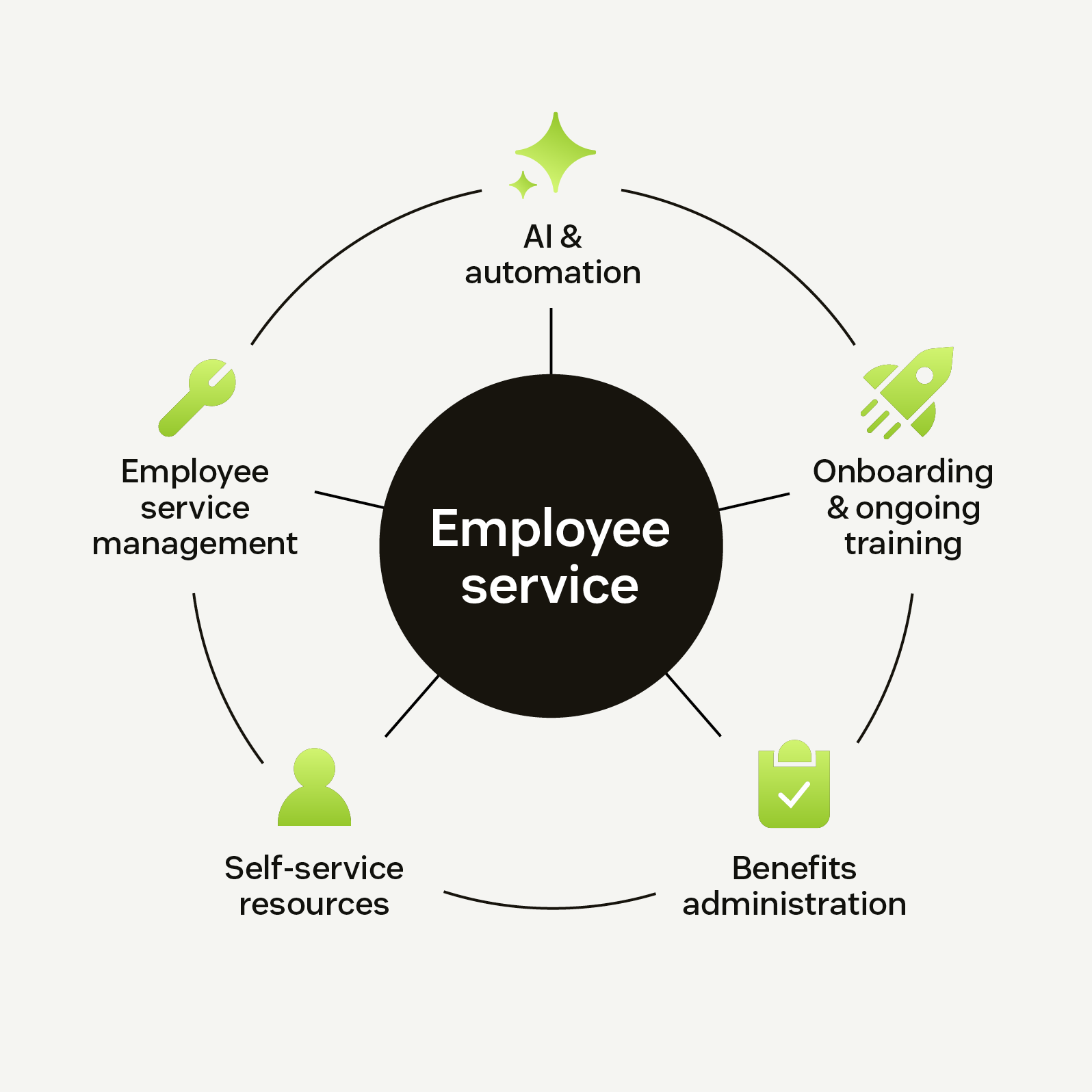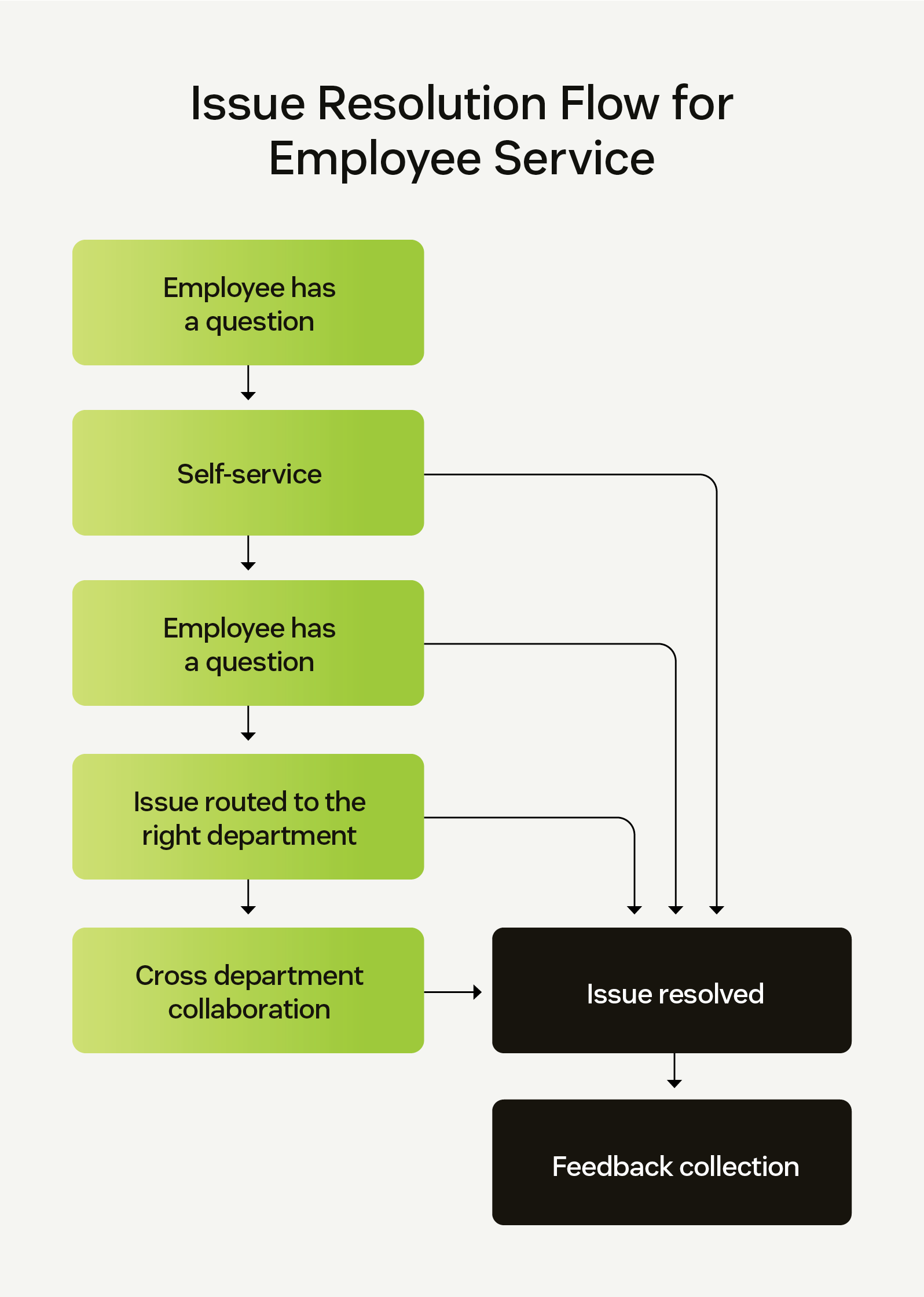Article
What is employee service? A complete guide
Strong employee service leads to more efficient operations and a better experience for everyone. Here’s what it is, how it works, and why it's important.
Justine Caroll
Director, Product Marketing
최종 업데이트: August 26, 2025
Employee service definitionEmployee service refers to the internal support and resources a business provides its employees. This includes everything from onboarding, training, and managing benefits to resolving IT issues or providing quick answers through AI agents. Its purpose is to reduce friction across the employee journey and make it easier for people to get the help they need. |
Remember the Parks and Recreation episode where Leslie Knope tries to fill a pothole and gets lost in a maze of bureaucratic red tape? That’s what happens when employee service breaks down. People get stuck, frustrated, and productivity slows to a crawl. But when internal customer service systems work well, employees can focus on what they do best instead of wrestling with confusing processes.
Exceptional employee service creates a smooth path to an efficient, productive workplace. It removes friction from daily tasks, connects employees to the right resources, and gives teams more time to focus on meaningful work. Think of it as internal customer support with a strategic focus.
According to the Zendesk Employee Experience Trends Report 2024, 83 percent of IT and HR leaders say employee experience is a top priority, and employee service plays a central role in shaping it. With the right systems in place, businesses can reduce confusion, eliminate repetitive back-and-forth, and provide fast, consistent support across the board.
In this post, we’ll break down what employee service is, why it matters, and how to deliver it effectively. You’ll find practical examples, measurable benefits, and proven best practices for creating internal support systems that actually work, no red tape required.
More in this guide:
- What is an example of employee service?
- How does employee service work?
- Benefits of employee service
- Key components of employee service
- Employee service best practices
- How to measure employee service
- Frequently asked questions
- Elevate your employee service with Zendesk
What is an example of employee service?
Employee service shows up in the everyday moments when people need help getting things done. These interactions happen across departments and touch nearly every aspect of work life.
Consider these common scenarios where employee service comes into play:
- HR-related requests: Benefits inquiries, employee leave requests, onboarding new hires, and offboarding. Confidentiality and enterprise-grade data protection are key here.
- IT assistance: Requests for hardware or software, resolving technical issues, managing system changes, and handling common needs like password resets or access requests.
- General internal queries: Accessing policies, managing tool requests, or routing cross-departmental project questions.
The infrastructure supporting those interactions ties all of this together. A centralized service log, an adaptable agent workspace, and intelligent routing all help ensure employees get fast, accurate support no matter who they’re working with.
How does employee service work?
Employee service functions by providing structured, accessible pathways for employees to get the help they need. It combines self-service tools, automated workflows, and integrated support channels to deliver fast, reliable assistance.
Modern employee service solutions meet employees where they already are, like Slack, Microsoft Teams, and internal portals, meaning support doesn’t interrupt their workflow. Because requests often touch more than one team, many businesses are building collaborative internal service environments that allow HR, IT, Finance, and others to resolve complex issues while minimizing back-and-forth.
This is where employee service management (ESM) plays a supporting role. It brings these service elements together under a unified structure that helps teams manage requests consistently and with complete visibility.
Employee service vs. customer service
While employee service and customer service share a foundation in resolving issues and delivering value, they serve different audiences.
- Employee service is internal-facing, focusing on helping employees get answers, resolve problems, and access resources so they can stay focused and productive.
- Customer service is external-facing, ensuring customers get what they need to stay loyal.
But the two aren’t isolated. Zendesk benchmark data shows that 87 percent of IT and HR leaders believe the employee experience directly impacts the customer experience.
Strong internal support often translates into better customer-facing interactions. This idea is sometimes referred to as total experience (TX), where employee and customer service efforts are aligned and mutually reinforcing.
Employee service vs. employee experience
That said, it’s important to distinguish employee service from broader concepts like employee experience.
- Employee experience includes everything from culture and career development to employee engagement.
- Employee service focuses specifically on the systems and workflows that enable employees to get answers, solve problems, and do their jobs effectively.
It also differs from employee service management, which refers to the operational strategy and infrastructure behind employee service. While employee service is about the day-to-day interactions that support employees, ESM aligns internal teams like HR, IT, finance, and facilities through shared workflows, intelligent automation, and self-service tools.
Benefits of employee service
Employee service drives measurable business value beyond making internal teams run smoother. Here are a few key benefits of employee service.
- Increased productivity and efficiency: Employees spend less time stuck or waiting for help. Self-service tools, automated workflows, and AI-powered suggestions free them to focus on strategic work.
- Boosted employee satisfaction: When people get quick, accurate answers, they feel respected and supported. Consistent service builds trust.
- Reduced employee turnover: Clear, accessible support shows a commitment to employee well-being. That increases loyalty and reduces burnout.
- Improved workplace culture: Reliable internal service creates a sense of consistency and respect. It supports a workplace where people feel heard and want to stick around.
These outcomes directly impact engagement, retention, and bottom-line performance. With the right tools and workflows in place, internal support can move from reactive to strategic, helping everyone in the organization work smarter and faster.
Key components of employee service
Employee service is like the Parks and Recreation department itself. Just as Pawnee’s government works best when different departments collaborate (even if Ron Swanson prefers to work alone), effective employee service brings together several components that work harmoniously to deliver seamless internal support.
These elements collectively manage internal requests and ensure employees have the resources they need. They centralize support, empower self-help, and streamline complex processes, creating a more efficient and responsive internal environment.

Employee service management
Centralized case management ensures nothing falls through the cracks. With a unified workspace, agents get full context when they receive a request. They can assign subtasks, leave notes, and collaborate with other departments without switching tools.
Example scenario: An HR representative receives a question about a specific employee benefit not typically handled by HR. Instead of juggling multiple systems or emailing colleagues, their unified agent workspace provides a complete history of the employee’s past interactions, relevant personal details, and a clear path to collaborate with the benefits administration team. They can add a note, assign a sub-task to the benefits specialist, and track its progress without leaving the conversation with the employee. |
AI and automation
AI in the workplace can do more than just handle repetitive questions. It improves internal service over time. AI and automation can:
Route requests to the right team based on urgency or topic.
Guide agents through standard operating procedures for fast service that’s consistently compliant.
Analyze past interactions to recommend future automation opportunities.
Zendesk AI is pre-trained on HR and IT use cases, which means teams can start seeing value fast. Benchmark data shows 79 percent of leaders agree that AI improves work quality by handling repetitive tasks, resolving issues autonomously, and enhancing training and personalization.
Example scenario: An employee needs to update their direct deposit information but can’t find the right form. Instead of calling HR, they simply ask an AI agent via an internal portal or messaging channel like Slack. The AI agent instantly understands the intent, provides a direct link to the secure form, and walks the employee through the necessary steps, ensuring their information is updated quickly and accurately, even outside of business hours. |
Self-service resources
A strong AI knowledge base gives employees the confidence to help themselves. With generative AI, building and maintaining help articles is easier than ever.
AI can also flag outdated content or suggest new topics based on search patterns. That means the more your employees use it, the smarter and more useful your self-service system becomes.
For example, the U.K.-based grocery chain Tesco provides employee self-service to a staff of 46,000. Using Zendesk, employees view around 30,000 articles a week across multiple internal help centers, achieving an impressive 73 percent self-service rate.
Example scenario: An employee wants to know how to upgrade their device to the latest macOS. Instead of submitting a ticket and waiting for a response, they check the internal knowledge base. Within seconds, they find the step-by-step upgrade instructions, saving time for themselves and the IT service team. |
Onboarding and ongoing training
Employees need clear access to systems, policies, and tools from day one. Automated employee onboarding workflows ensure new hires get what they need without delay. And when it’s time to train or re-certify, AI agents can surface learning materials or route requests to the right team.
Benefits administration
Managing leave, life events, or time off shouldn’t require a paper trail. Employee service tools standardize these processes, ensuring that employees know what’s expected and that agents have the context to support them quickly.

Employee service best practices
Implementing employee service effectively requires a strategic approach focused on accessibility, efficiency, and security. These best practices align with the core pillars of making it easy for employees to get help, empowering support teams, scaling operations, and protecting sensitive data.
- Meet employees where they are: Support should be available across Slack, Microsoft Teams, and other internal channels. Don’t make employees jump through hoops.
- Use AI agents for 24/7 support:Instant answers at any time, any place, and in any language reduce wait times and free up human teams.
- Build intelligent knowledge bases: Self-service only works when content is accessible and accurate. AI helps keep it that way.
- Automate workflows: From employee onboarding to equipment requests, automation reduces bottlenecks and adds transparency.
- Embrace omnichannel communication: Meet employees where they are across multiple platforms and channels.
- Protect employee data: Internal support requires strict security. Encryption, role-based access, and data masking are essential.
- Track employee service metrics: Employee satisfaction (ESAT), first-response time, resolution time, and self-service rates offer insight into where to improve.
- Monitor progress and keep improving: AI-powered reporting, QA tools, and employee feedback help teams spot gaps and refine service.
These best practices help form the foundation for a scalable, resilient internal support system. The goal is to make it easy for employees to get the help they need without friction, so teams can focus on meaningful work instead of chasing down answers.
How to measure employee service
Measuring employee service is critical for understanding its impact and identifying opportunities for continuous improvement. This goes beyond simple feedback and digs into key performance indicators (KPIs) that reflect agent performance, efficiency, satisfaction, and business outcomes.
You can gain insights by tracking metrics such as:
- Resolution times: How quickly employee requests are being addressed.
- Self-service rates: How often employees find answers without needing direct assistance.
- ESAT/CSAT scores: Directly gauging how satisfied employees are with the support they receive.
- Productivity figures: Observing how streamlined service contributes to overall employee output.
- Employee engagement: Tracking engagement can reveal whether employees feel supported and equipped to do their best work.
Tools like predictive analytics, listening tools (for continuous feedback), and AI analytics can provide deeper insights, helping to identify trends and areas for optimization. Establishing clear metrics and integrating findings into evaluations allows organizations to create workplace cultures where feedback directly leads to meaningful enhancements in service delivery.
Frequently asked questions
Customer story


UTi
UTi's HR team utilizes custom analytics to earn 98% employee satisfaction
“Honestly, if it weren’t for Zendesk Support, it would take us a lot more time and effort to get through the tasks we have.”
- Noal Robinson
Shared Services manager
Elevate your employee service with Zendesk
Like how Leslie Knope transformed the Parks department by making government work for the people instead of against them, employee service helps build a stronger foundation for the entire organization. It creates clarity, reduces delays, and supports employees through every stage of their journey. When internal systems work well, people work better.
Employee service software from Zendesk gives teams the tools to make that happen, combining AI, automation, and intuitive design in a platform built for seamless internal support. From real-time assistance to smart reporting and security-first features, Zendesk can meet and exceed modern employee expectations and evolve with your business.
Explore how Zendesk can help you simplify internal service and bring more value to your teams.
